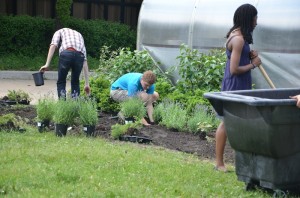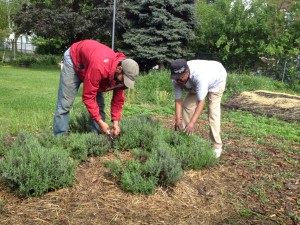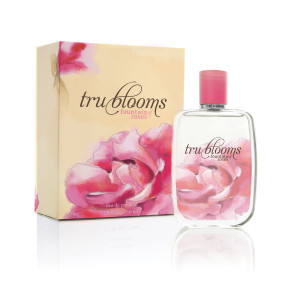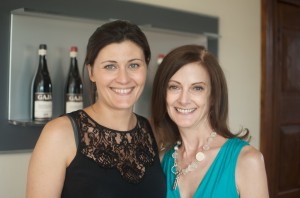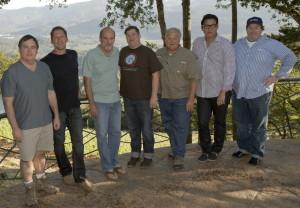What does Chicago smell like? That’s the challenge that Tru Fragrance, a private label perfume company based in the Windy City set out for itself in 2011. The team behind the label wanted to create something not done before in the fragrance world, specifically a “homegrown” scent, one planted, grown, gardened, harvested and bottled in one season, from a specific place, like Chicago.
In 2012 there were about 1,100 new fragrances released in the US market. Some have done very well, others were as fleeting as their scents. But none of those perfumes have a concept like Tru Blooms Chicago, which is a fragrance truly made in Chicago. Made in Chicago means planted, grown and harvested by Chicagoans. It’s a community project, with many benefits beyond making a unique, beautiful scent.
Why Chicago? Simply for the reason that it is home to Tru Fragrance and seemed the most natural candidate as the first city for a homegrown fragrance. “We called it Tru Blooms Chicago because it is very much about the city of Chicago,” says Paul Leroue, one of the principals involved in the project. They chose the flowers based on what thrives well in Chicago, which for the first scent, or first harvest as they call it, in 2012 were roses, lavender and violet. They came up with the idea of partnering with the city parks department to find plots of land in the city — downtown and in the suburbs — where planting gardens would help with citywide beautification, and get Chicagoans involved in planting and caring for the flowers. Each garden boasts a sign that reads “These flowers are being grown for Tru Blooms Perfume.”
A rather brilliant idea. The city of Chicago certainly thought so. Paul says, “the sustainability officer of the city got excited about it. She said this is right with what our mayor wants to do which is to change Chicago and make it about urban beautification.” So they got garden plots in places like Grant Park, the Chicago Botanic Garden, Bowmanville Garden, and even a small plot at O’Hare airport (in the American Airlines terminal) where they could plant and garden, with the help of various non-profit organizations. Tru Blooms pays for all the plants. “The fact is they have more places to plant flowers than they have funds, so someone like us coming along saying why don’t we take those gardens for you was really big,” says Paul.
Many of the non-profits involved include Growing Home, NeighborSpace, the Peggy Notebaert Nature Museum and Chicago Botanic Garden’s community garden programs such as Windy City Harvest and Green Youth Farm.
One big element of the Tru Blooms project is job creation — specifically the urban farmers, locals who didn’t necessarily have gardening skills, but have learned along the way. Some positions are seasonal, some are more year round. The jobs are funded by the fees that Tru Blooms pays for use of the land. In 2012 there were 21 gardens; for the second harvest in 2013 there are 28 plots. In 2012 Tru Blooms Chicago provided job training to 150 people, creating more than 60 jobs for Chicagoans.
One of these urban farmers is Joey Smith, Jr. “It’s an awesome experience,” he says. “I didn’t think I’d be doing anything like this.” Joey works with Windy City Harvest, which is a department within the Chicago Botanic Garden. He came out of a boot camp program for the Cook County inmate system where there happens to be a garden. Windy City Harvest offers job training to those who seem most interested in gardening. “I learn at least 10 to 15 things a day,” Joey says, as he’s been planting, watering, weeding and harvesting the flowers. He really likes the smell of the lavender and the rose geranium. Joey finds growing flowers for a perfume “intriguing,” so much so that he’s now planning a career in gardening. “I’m eager to take advantage of this opportunity as best I can because not everyone gets an opportunity like this and I’m grateful for it.”
Once word got out, Tru Blooms started getting phone calls from organizations that also wanted to take part in the perfume creation project. “Garfield Park called us up and said we have a small plot of land.” Paul says for 2013 they are working with a local school, Whitney Young High School. “Their biology teacher called us up and said ‘I love what you are doing. We are trying to teach our kids how to garden. They have a greenhouse and they have plots of land. We would love to be a spot for you this year,'” Paul tells me. They are growing rose, lavender, rose geranium and patchouli.
This is not a mass produced, mass marketed perfume, nor does it have a celebrity fronting the fragrance. In fact it’s about the furthest you can get from a celebrity perfume. The people of Chicago and the gardens of Chicago are the real faces here, not some model or celebrity. About 7000 bottles were made last year, sold in high end hotels, local boutiques and near tourism centers. It’s meant to be an exclusive perfume, one you won’t find everywhere, and for now, one you won’t find outside of Chicago, although Paul says they’ve tracked sales to people in seven states outside of Illinois (the perfume is available online).
For the 2013 harvest of Tru Blooms Chicago, the floral mix has been fleshed out, with more rose, additions of kumquat, patchouli, rose geranium and lily. Because there’s more rose this harvest, the fragrance is being called Tru Blooms Fountain of Roses.
In its first year Tru Blooms Chicago is close to being sold out and there was no question a second harvest scent would be made. The concept seems perfect for taking to other cities and Paul says that they will most definitely come out with at least one or two other city editions in 2014. It’s an innovative concept, one that goes far beyond just creating a beautiful fragrance; it’s creating a beautiful environment and community as well.
The second Tru Blooms Chicago harvest scent, Fountains of Roses, will be available for sale beginning October 14 online and at select locations throughout Chicago. $20 for 15 ml; $42 for 50 ml.


